Computex 2005 Day 2 - ULi's new Athlon 64 Chipset, G70, CrossFire & more
by Anand Lal Shimpi on June 1, 2005 1:57 AM EST- Posted in
- Trade Shows
ULi - The Best Kept Secret of Taiwan?
About two years ago failing chipset maker ALi dropped out of the chipset business and a spinoff, ULi, took over. ALi reached the height of their popularity during the Socket-7 days, but when Intel transitioned to their Slot-1 architecture ALi began to lose ground. While ALi was one of the first to show working Athlon 64 chipsets, their K8 solutions were hardly adopted and thus the market was given away to SiS, VIA and of course, NVIDIA.
ULi’s existence was supposed to change all of that. Focusing on stability and reliability, two issues that ALi’s chipsets proved to have later on in their life, ULi was determined to create a chipset business that would be among the best.
Currently ULi has manufacturers like ASUS, ABIT and ECS making boards based on their chipsets, yet none of the sales people from those companies will sell ULi based motherboards into the North American and European markets. In the Chinese markets, the ULi based boards sell extremely well. The chipsets themselves are priced lower than VIA’s, yet are quite competitive with NVIDIA’s nForce4 Ultra solution. The problem is branding; ULi has no brand recognition in the Europe and North American markets, thus selling motherboards based on their chipsets becomes quite difficult.
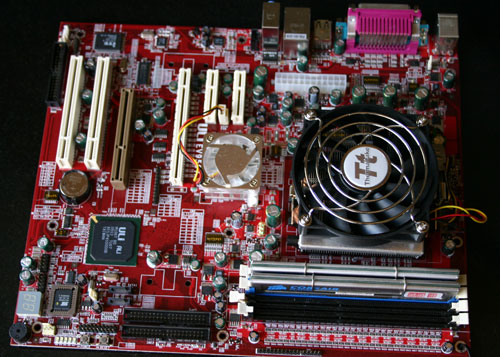
We took a look at a ULi Socket-939 PCI Express reference board while in Taiwan to see if what ULi was telling us happened to be true. Could ULi’s chipsets offer performance close to that of NVIDIA, while also offering stability at a price point lower than VIA’s?
We ran a small suite of tests on ASUS’ AN8-SLI Deluxe (nForce4 SLI) as well as ULi’s Socket-939 PCI Express Reference Motherboard. The performance of the chipset was quite compelling; faster than the nForce4 in Doom 3, yet slower in the Winstone tests.
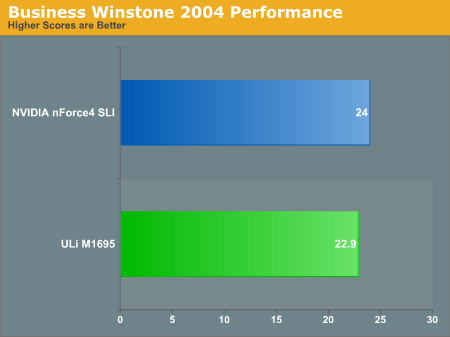
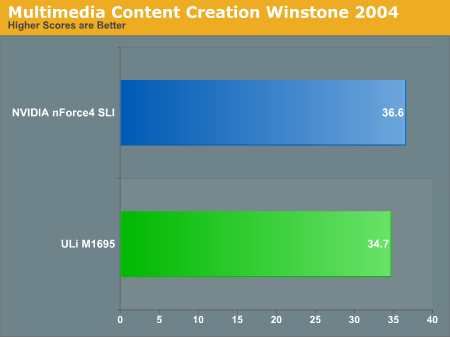
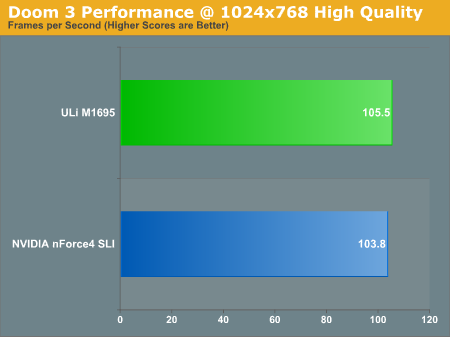
Overall performance was quite respectable, but most importantly was that we encountered no problems during our testing. Overclocking features were limited on the reference board, but we’re hearing that ABIT has a board based on ULi’s chipset that should offer some pretty good overclocking performance.
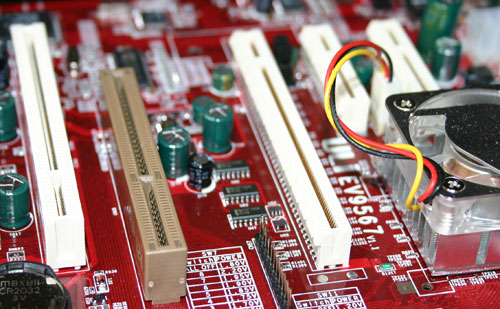
One particularly nice feature of the ULi chipset is that its South Bridge offers a full speed AGP 8X interface - and the North/South Bridges communicate over a 8GB/s Hyper Transport bus, meaning that there’s no reduction in performance if you use an AGP graphics card on the motherboard. By offering both AGP and PCI Express slots, both of which run at full speed, you can have a single motherboard that will support your current AGP graphics card and any later on PCI Express cards without sacrificing any performance.

The Current M1567 South Bridge has full AGP 8X Support
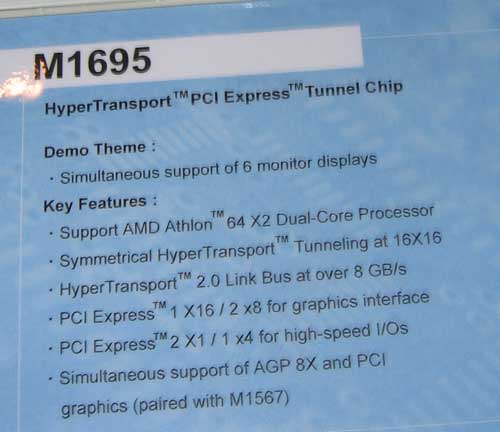
The Spec list of the M1695 ULi chipset
Currently ULi has the manufacturer support they need, they simply need to be able to improve brand recognition it seems. With the right combination of getting their name out there and a solid enthusiast-level motherboard, ULi could very well be the chipset manufacturer to pick up where VIA left off.
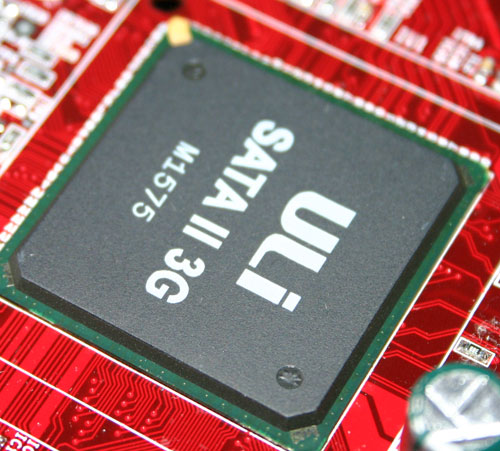
The new M1575 South Bridge will add SATA II support
Current pricing for Socket-939 motherboards based on the ULi chipset appears to be at the sub-$80 level, which isn’t bad at all for a nForce4 Ultra competitor.

ULi also makes most of the South Bridges for ATI based motherboards
We saw ULi boards from a few manufacturers at the show; ECS' board looked a lot like ULi's reference design and will carry a street price of around $75:

Jetway also had a motherboard on display:
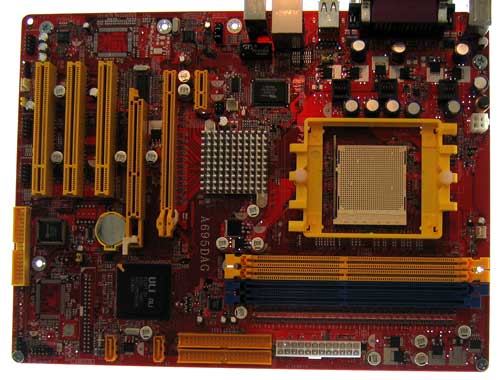
While ASUS and ABIT also have boards, we did not get a chance to take a look at them at the show.










53 Comments
View All Comments
Tanstafl - Tuesday, June 7, 2005 - link
#52, the reason they chose to use a PCI slot is most likely because that allows them to use standby power to retain the content of the RAM drive. If you check what's been written about the Gigabyte RAM disk card you will find that the battery is only used when the machine is unplugged, or when there is a power outage.erwos - Friday, June 3, 2005 - link
"#50, yeah there is another purpose other than power. The PCI slot holds the card in place so it doesn't rock around inside your tower. :)"Again, you don't need a PCI slot for that. A mounting bracket would solve that just fine, and possibly even give me room for two in a single 5.25 bay. It's solid state - the thing isn't going to move.
mlittl3 - Thursday, June 2, 2005 - link
#50, yeah there is another purpose other than power. The PCI slot holds the card in place so it doesn't rock around inside your tower. :)erwos - Thursday, June 2, 2005 - link
My _theory_ is that the PCI bus is used for something other than just power. Maybe some kind of configuration and/or debugging. I find it tough to believe they made this thing use PCI for power alone, because a simple 4-pin would have solved that pretty easily.-Erwos
KayKay - Thursday, June 2, 2005 - link
Wow, this was an excellent article, one of the best i've seen to date.AGP and PCI-E on the same board, don't see much of that, but im sure people out there would appreciate it if it was widely available
nserra - Thursday, June 2, 2005 - link
#40 What are you talking about I have been installing PC's with ASrock boards (K8 Combo-Z and K8Upgrade-1689) and all super stable and fast (boot time records!!!). I have to say that these are all much faster than the asus boards that I was installing (K8V SE, ...)You must have been unlucky, and don’t forget one thing if mobo makers and bios makers put the same affords they do on intel chipsets, I doubt that Uli and Sis looked so bad...
jiulemoigt - Thursday, June 2, 2005 - link
this is wrong pikhttp://images.anandtech.com/reviews/tradeshows/200...
on p9
http://www.anandtech.com/tradeshows/showdoc.aspx?i...
there is three dead give aways one which i feel like
an idiot for missing is the VGA connector and the
others are the audio jacks are sperated in one pik but not in the cut away and it still supports two ethernet adapters which is also missing in the second pik.
Penth - Wednesday, June 1, 2005 - link
mosoon:You are right with your guess that even the newest and fastest SATA drives fail to max out a SATA I connection. I think my Raptor maxes out at about 70-something MB per second. Not even half the capability of the SATA interface.
I am supremely interested in this card, but I think if I was going to be paying that much per GB, I would wait for a SATA II connection, where the increase in bandwidth would be very apparent with 300MB/s sustained transfers.
monsoon - Wednesday, June 1, 2005 - link
MLITTL3 forgive my ignorance, but how does it come that data transfer through the SATA connector is faster when pumped by the i-RAM instead of a SATA HD ?i mean, ok, i understand HD access latency is lower, but shouldn't we already have the SATA BUS at its max if we buy some kick ass SATA HD ?
or is it that SATA HDs around ( including RAPTORS, etc.. ) come nowhere near the bandwidth possibility of the SATA bus ?
cordially,
JOHN
PS - please bear with my ignorance !!!
DanDaManJC - Wednesday, June 1, 2005 - link
hmmm that ULi mobo, well specifically their chip that allows both agp and pci-express looks awesome!I've been waiting around for a solution like that... now all I need is $500 for the rest of the pc... haha *sigh*